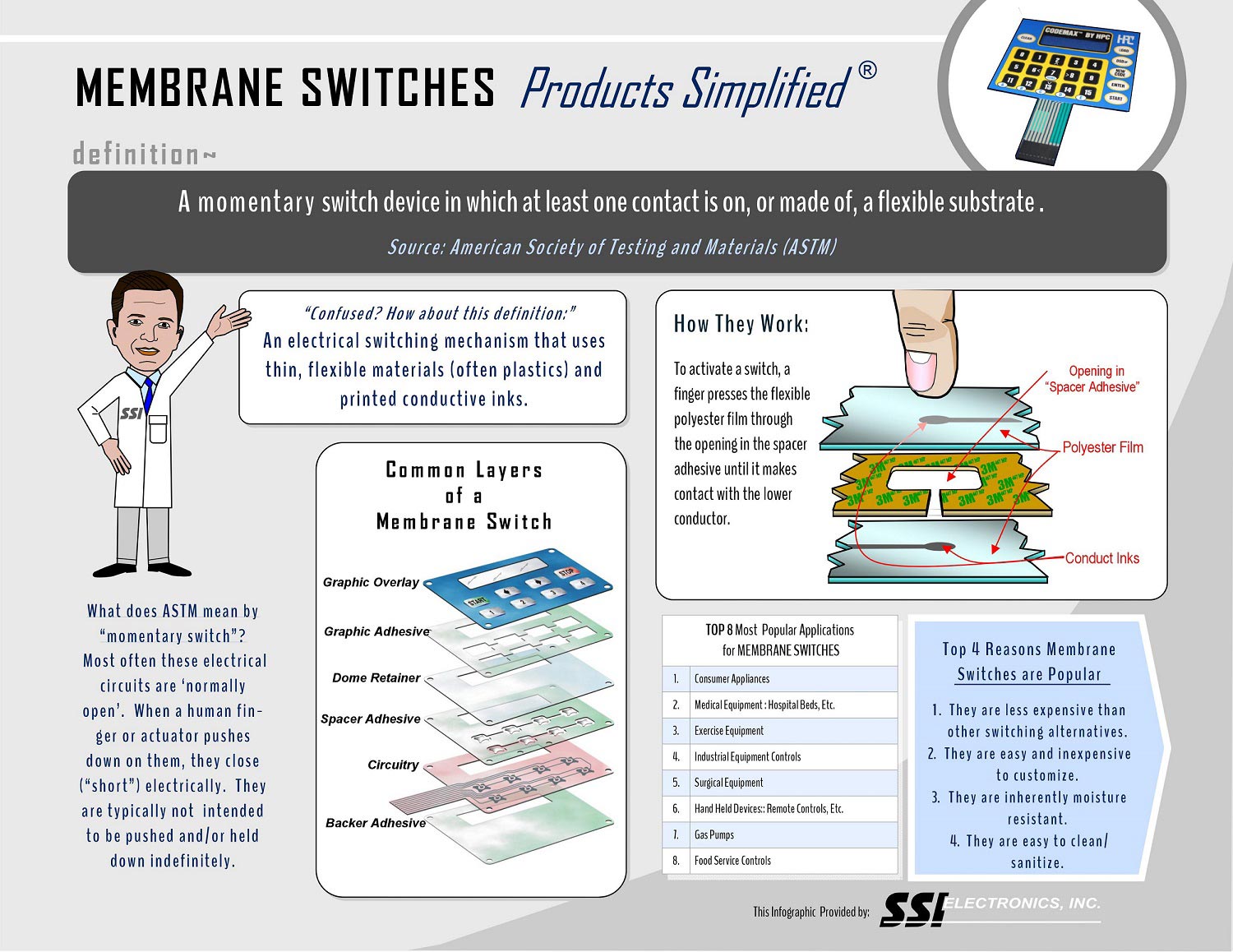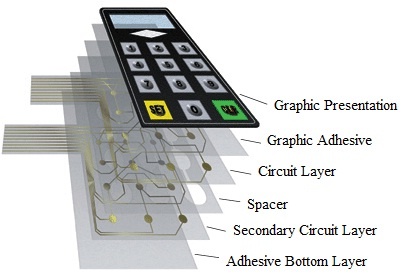Comprehending the Value of Membrane Layer Switch Over in Modern Electronic Devices
Membrane layer switches are indispensable parts in modern-day electronic tools. They supply a mix of performance and design that improves individual interaction. Their lightweight and resilient nature makes them ideal for numerous applications. As industries advance, the need for personalization and advanced functions expands. Recognizing how membrane layer changes add to advancement exposes their importance in shaping the future of electronic devices. What lies ahead for this technology?
The Essentials of Membrane Change Innovation
Although often neglected, membrane switch modern technology plays a crucial role in the modern electronic devices landscape - membrane switch. These devices, composed of several layers, act as interface for different electronic products, ranging from family appliances to medical tools. A typical membrane layer switch contains a graphic overlay, a spacer layer, and a circuit layer, which are carefully constructed to develop a functional interface.When stress is related to the overlay, the circuit layer is finished, allowing signals to be sent to the device. This innovation is understood for its convenience, making it possible for customization in functionality, style, and shape to meet details user requirements. Furthermore, membrane layer buttons are slim and light-weight, making them suitable for applications where space is a premium. Their toughness and resistance to environmental aspects better boost their allure, ensuring they can hold up against rough problems while preserving capability. In general, membrane button modern technology is integral to creating efficient and easy to use digital gadgets

Trick Advantages of Membrane Layer Changes
Membrane switches over offer several vital benefits that make them a favored choice in various electronic applications. Their layout enables for a compact type element, making it possible for makers to create smooth and lightweight devices. Furthermore, membrane switches are resistant to dirt, dampness, and chemicals, which enhances their longevity and long life popular atmospheres. The responsive feedback supplied by these switches can boost user experience, making them simple and intuitive to operate.Furthermore, membrane layer switches can be customized with varied graphics and shades, enabling for unique branding opportunities. The production procedure is normally affordable, specifically for high-volume manufacturing, as it lowers setting up time and streamlines design. Membrane layer changes call for minimal upkeep, contributing to lower general functional prices. These advantages highlight their expanding appeal in contemporary electronic devices, where reliability and user-friendly interfaces are crucial.

Applications Across Various Industries
The convenience of membrane layer changes allows their extensive fostering across various industries. In the clinical field, they are commonly made use of in analysis devices and person tracking systems, supplying a long lasting interface immune to contaminants. The automotive sector uses membrane layer switches for control panel controls, improving customer experience with sleek styles that withstand extreme conditions. In consumer electronic devices, they offer as control board for gadgets such as microwaves and coffee machine, offering an user-friendly user interface that is very easy to clean. The aerospace field utilizes membrane layer buttons in cockpit controls, where reliability and room efficiency are vital. In addition, the industrial field leverages these switches in machinery and control systems to ensure robust operation sought after environments. This broad variety of applications underscores the flexibility of membrane layer buttons, making them essential elements in improving performance and user communication across varied technological landscapes.
Personalization and Style Versatility

Future Fads in Membrane Switch Over Advancement
Arising fads in membrane switch advancement suggest an expanding focus on enhanced capability and integration with wise modern technologies. As customer need for more sophisticated electronic tools rises, producers are concentrating on creating membrane layer switches over that not just offer fundamental functional functions yet additionally include functions like touch sensitivity, backlighting, and haptic feedback.Furthermore, developments in products are expected to boost longevity and ecological resistance, making membrane layer changes suitable for varied applications in markets such as healthcare, automobile, and consumer electronics. The assimilation of capacitive touch innovation is likely to become a lot more prevalent, allowing for sleeker designs and boosted individual interfaces. membrane switch.Additionally, the surge of the Web of Things (IoT) is prompting the growth of membrane switches over that can communicate wirelessly with various other gadgets, improving interconnectivity. Generally, the future of membrane button technology shows up encouraging, driven by advancement and the pursuit of straightforward options
Frequently Asked Inquiries
Exactly How Do Membrane Changes Contrast to Conventional Mechanical Switches?
Membrane buttons, being more space-efficient and providing a click resources smooth style, comparison with standard mechanical buttons that offer responsive feedback. The former usually feature customizable graphics, while the latter commonly guarantee longevity and dependability in numerous applications.
What Materials Are Typically Made Use Of in Membrane Change Manufacturing?
Membrane layer switches are typically generated making use of materials such as polyester, polycarbonate, and printed conductive inks. These products offer versatility, responsiveness, and go resilience, making them appropriate for various applications in electronic devices and interface.
Can Membrane Changes Be Fixed or Recycled?
Membrane switches can frequently be repaired, particularly if small concerns occur, such as adhesive failing or surface damage. Total reuse is generally limited due to use and prospective deterioration of materials over time.
Just How Do Environmental Variables Affect Membrane Layer Change Performance?
Ecological factors, such as moisture, temperature, and direct exposure to chemicals, substantially influence membrane layer switch efficiency. Extreme problems can result in deterioration, affecting responsiveness and durability, ultimately jeopardizing the functionality of the tool in different applications.
What Is the Regular Lifespan of a Membrane Layer Change?
The regular lifespan of a membrane button generally varies from 1 to 5 million actuations, relying on elements such as usage regularity, ecological conditions, and the products utilized in production, impacting longevity and performance long life. A regular membrane layer switch consists of a visuals overlay, a spacer layer, and a circuit layer, which are thoroughly assembled to develop a practical interface - membrane switch.When pressure is applied to the overlay, the circuit layer is finished, enabling signals to be transmitted to the device. The tactile comments offered by these switches can boost individual experience, making them very easy and instinctive to operate.Furthermore, membrane buttons can be customized with varied graphics and shades, permitting for one-of-a-kind branding possibilities. As consumer need for a lot more advanced electronic devices increases, producers are concentrating on creating membrane changes that not only serve standard operational functions but also include functions like touch sensitivity, backlighting, and haptic feedback.Furthermore, developments in materials are anticipated to improve resilience and ecological resistance, making membrane changes ideal for varied applications in sectors such as medical care, automobile, and customer electronic devices. The combination of capacitive touch innovation is most likely to come to be a lot more widespread, allowing for sleeker styles and enhanced individual interfaces.Additionally, the increase of the Web of Points (IoT) is motivating the advancement of membrane switches that can communicate wirelessly with other tools, boosting interconnectivity. Membrane layer switches, being extra space-efficient and supplying a streamlined design, comparison with typical mechanical buttons that provide tactile feedback
Comments on “Top considerations when choosing a membrane switch for aerospace use”